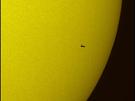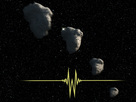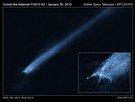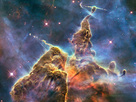Surprising signs of unrest in massive star cluster
Hubble catches stars on the move
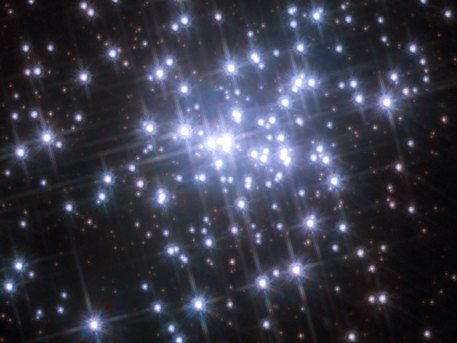 © NASA, ESA and Wolfgang Brandner (MPIA), Boyke Rochau (MPIA) and Andrea Stolte (University of Cologne)
|
The core of the star cluster in NGC 3603 is shown in great detail in an image from the Wide Field Planetary Camera 2 (WFPC2) camera on the NASA/ESA Hubble Space Telescope. The image is a colour composite of observations in the WFPC2 filters F555W (blue), F675W (green) and F814W (red). This view shows the second of two images taken ten years apart that were used to detect the motions of individual stars within the cluster for the first time. The field of view is about 20 arcseconds across.
A team of astronomers from the Max-Planck Institute for Astronomy in Heidelberg and the University of Cologne led by Wolfgang Brandner (MPIA) wanted to track the movement of the cluster’s many stars. Such a study could reveal whether the stars were in the process of drifting apart, or about to settle down.
The cluster, formally known as the NGC 3603 Young Cluster, is about 20 000 light-years from the Sun which makes these measurements extraordinarily difficult. It is necessary to compare images that were made years or even decades apart. The telescope and camera used must give very sharp images and be extremely stable over long periods.
Brandner and his colleagues realised that the Hubble Space Telescope was the best for the job. They found good data in the archives for the NGC 3603 cluster from a July 1997 observing run with the Wide Field Planetary Camera 2 (WFPC2), and then made their own follow-up observations in September 2007, using the same camera and the same set of filters as in the original observations. It then took the team two years of very careful analysis to extract reliable estimates for the motions of stars in the images.
Boyke Rochau (MPIA), the paper’s lead author, who performed this analysis as part of his PhD work, explains: ”Our measurements have a precision of 27 millionths of an arcsecond per year. This tiny angle corresponds to the apparent thickness of a human hair seen from a distance of 800 km.”
In this laborious way, they were able to measure the precise speeds of more than 800 stars. About 50 were identified as foreground stars that are unrelated to the cluster, but more than 700 cluster stars of different masses and surface temperatures remained. The results for the motion of these cluster stars were surprising: this very massive star cluster has not yet settled down. Instead, the stars’ velocities were independent of their mass and thus still reflect conditions from the time the cluster was formed, approximately one million years ago.
Stars are born when a gigantic cloud of gas and dust collapses. In cases such as the star forming region NGC 3603, where the cloud is unusually massive and compact, the process is particularly quick and intense. Most of the cloud’s matter ends up concentrated inside hot young stars and the cluster keeps much of its initial gravitational attraction [2]. In the long term such massive compact star clusters may lead to the development of the huge balls of stars known as globular clusters, whose tightly packed stars remain held together by gravity for billions of years.
Wolfgang Brandner adds: ”This is the first time we have been able to measure precise stellar motions in such a compact young star cluster.” Team member Andrea Stolte from the University of Cologne adds: “This is key information for astronomers trying to understand how such clusters are formed, and how they evolve.”
Notes
[1] For comparison: in our own immediate stellar neighbourhood, the same volume contains no more than a single star, namely the Sun. The NGC 3603 nebula is located in the central plane of our home galaxy's main disc, in a region called the Carina spiral arm.
[2] More usually the gas cloud is bigger and less massive and only about 10% of this mass ends up inside stars. The remaining gas is then blown away by the fierce ultraviolet light and stellar winds from the hot young stars. Once the interstellar matter is dispersed, the young star cluster has lost nearly 90% of its initial mass and has insufficient gravitational attraction to keep together. The stars in such typical clusters gradually drift apart.
Source: Hubble
Surprising signs of unrest in massive star cluster
Hubble catches stars on the move
 © NASA, ESA and Wolfgang Brandner (MPIA), Boyke Rochau (MPIA) and Andrea Stolte (University of Cologne)
|
The core of the star cluster in NGC 3603 is shown in great detail in an image from the Wide Field Planetary Camera 2 (WFPC2) camera on the NASA/ESA Hubble Space Telescope. The image is a colour composite of observations in the WFPC2 filters F555W (blue), F675W (green) and F814W (red). This view shows the second of two images taken ten years apart that were used to detect the motions of individual stars within the cluster for the first time. The field of view is about 20 arcseconds across.
A team of astronomers from the Max-Planck Institute for Astronomy in Heidelberg and the University of Cologne led by Wolfgang Brandner (MPIA) wanted to track the movement of the cluster’s many stars. Such a study could reveal whether the stars were in the process of drifting apart, or about to settle down.
The cluster, formally known as the NGC 3603 Young Cluster, is about 20 000 light-years from the Sun which makes these measurements extraordinarily difficult. It is necessary to compare images that were made years or even decades apart. The telescope and camera used must give very sharp images and be extremely stable over long periods.
Brandner and his colleagues realised that the Hubble Space Telescope was the best for the job. They found good data in the archives for the NGC 3603 cluster from a July 1997 observing run with the Wide Field Planetary Camera 2 (WFPC2), and then made their own follow-up observations in September 2007, using the same camera and the same set of filters as in the original observations. It then took the team two years of very careful analysis to extract reliable estimates for the motions of stars in the images.
Boyke Rochau (MPIA), the paper’s lead author, who performed this analysis as part of his PhD work, explains: ”Our measurements have a precision of 27 millionths of an arcsecond per year. This tiny angle corresponds to the apparent thickness of a human hair seen from a distance of 800 km.”
In this laborious way, they were able to measure the precise speeds of more than 800 stars. About 50 were identified as foreground stars that are unrelated to the cluster, but more than 700 cluster stars of different masses and surface temperatures remained. The results for the motion of these cluster stars were surprising: this very massive star cluster has not yet settled down. Instead, the stars’ velocities were independent of their mass and thus still reflect conditions from the time the cluster was formed, approximately one million years ago.
Stars are born when a gigantic cloud of gas and dust collapses. In cases such as the star forming region NGC 3603, where the cloud is unusually massive and compact, the process is particularly quick and intense. Most of the cloud’s matter ends up concentrated inside hot young stars and the cluster keeps much of its initial gravitational attraction [2]. In the long term such massive compact star clusters may lead to the development of the huge balls of stars known as globular clusters, whose tightly packed stars remain held together by gravity for billions of years.
Wolfgang Brandner adds: ”This is the first time we have been able to measure precise stellar motions in such a compact young star cluster.” Team member Andrea Stolte from the University of Cologne adds: “This is key information for astronomers trying to understand how such clusters are formed, and how they evolve.”
Notes
[1] For comparison: in our own immediate stellar neighbourhood, the same volume contains no more than a single star, namely the Sun. The NGC 3603 nebula is located in the central plane of our home galaxy's main disc, in a region called the Carina spiral arm.
[2] More usually the gas cloud is bigger and less massive and only about 10% of this mass ends up inside stars. The remaining gas is then blown away by the fierce ultraviolet light and stellar winds from the hot young stars. Once the interstellar matter is dispersed, the young star cluster has lost nearly 90% of its initial mass and has insufficient gravitational attraction to keep together. The stars in such typical clusters gradually drift apart.
Source: Hubble






